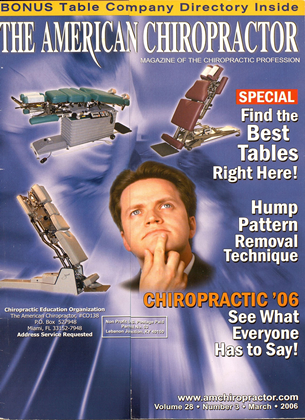Modern birthing procedures—even those with seemingly minimal intervention—arc known to cause trauma and stress to the infant's cranium and spine. In Bicdermann's text. Manual Therapy in Children, author R. Sachcr tells us, "When considering injuries and dysfunctions of the spine and its associated structures, the significance of birth trauma is often underestimated, and the resulting symptoms frequently misinterpreted." In the case of difficulty breastfeeding, as with many childhood disorders, the cause of the problem often traces back to undetected biomechanical injuries to the spine and cranium at birth. The failure to recognize these biomechanical injuries and their relationship to difficulty in breastfeeding leads to incorrect conclusions and, therefore, inadequate recommendations and treatments. Without real solutions, mothers become discouraged, successful breastfeeding is not achieved and women abandon the practice out of frustration. Breastfeeding is, by far, the best choice for infant feeding for numerous reasons. Significant research shows that, from a nutritional, immunological, digestive, neurological, developmental, mental, psychological and emotional standpoint, there is no replacement. Today, more and more women are choosing the healthy, natural benefits of breastfeeding. Exclusive breastfeeding is the optimal feeding mode for an infant's first six months of life. Many women initially plan to breastfeed for that length of time, yet fall short because of difficulties that seem to have no solution. Many of the care providers they consult are unaware of the biomechanical disorders in the infant's spines and craniums, which cause the difficulty in breastfeeding. This lack of knowledge leads to ineffective recommendations with poor results. Unless the biomechanical cause of these difficulties is addressed, women may become frustrated and abandon their original intent to breastfeed their babies. In these instances, it is imperative that family chiropractors offer mothers and their inlants care appropriate to their needs. Some of the most common indicators of difficulty with breastfeeding arc: Babies who cannot latch firmly Babies who can latch and not sustain sucking Babies who are unable to smoothly coordinate suckling, swallowing and breathing Babies who can feed in only one posi tion or postural Babies who seem dissatisfied when nursing and who remain fussy and distressed throughout the day Babies who chew and damage the mother's nipples Babies who may not feed any better from other devices Babies who have the need to suck 24/7 It has been my experience of 24 years in practice that, when infants presented in our office with the above signs, once evaluated and adjusted accordingly, they responded favorably with chiropractic care. Normal function in the infant was restored and breastfeeding continued without further complications and hindrances. Providing the mother with effective solutions allows the mother and child to continue to benefit from this superior practice of bonding and feeding. As doctors of chiropractic, it is our responsibility to inform parents about the importance of chiropractic care right from birth. Among other numerous benefits of chiropractic care for infants, the ability to successfully breastfeed has life long consequences for the baby's future health potential. A chiropractic evaluation should be included as a standard of care for all infants. Offering care for newborns may very well be one of the most important contributions chiropractic brings to the wellncss lifestyle. Dr. Jeanne Ohm instructs internationally on the topic "Chiropractic Care for Pregnant Women and Children. " She is executive coordinator of the International Chiropractic Pediatric Association and can be reached via their website at www.icpa4kids.com. |JQ*|
 View Full Issue
View Full Issue






